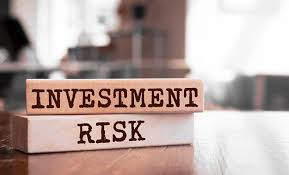
Investment Risks
Investing is a powerful way to grow your wealth and secure your financial future. However, every investment comes with its risks, and understanding how to manage these risks is key to success. Whether you’re a seasoned investor or just starting out, knowing how to minimize losses and maximize gains will help you achieve long-term financial stability. In this article, we will explore the types of investment risks, strategies to minimize those risks, and how to increase the potential for high returns.
1. What Are Investment Risks?
Investment risks refer to the possibility that the actual returns on an investment will differ from the expected returns. Risk is an inherent part of investing, and it comes in many forms, including market risk, interest rate risk, credit risk, and liquidity risk. Understanding these risks can help you take steps to reduce exposure and enhance your chances of making profitable decisions.
Types of Investment Risks:
- Market Risk: The risk of losses due to changes in the overall market, including stock market volatility.
- Credit Risk: The risk that a borrower may default on a bond or loan, causing the investor to lose money.
- Interest Rate Risk: Changes in interest rates can affect the value of certain investments, such as bonds.
- Liquidity Risk: The risk that you may not be able to sell an asset quickly without losing value.
- Inflation Risk: The risk that inflation will erode the purchasing power of your returns.
Being aware of these risks will help you make informed decisions about where and how to invest.
2. Diversification: A Key Strategy for Minimizing Investment Risks
One of the most effective ways to reduce investment risks is through diversification. Diversification means spreading your investments across different asset classes (stocks, bonds, real estate, commodities, etc.) to reduce the impact of any single loss on your overall portfolio.
Why Diversification Works:
- Reduces Volatility: A diversified portfolio tends to experience less dramatic swings in value since various asset classes often perform differently in changing market conditions.
- Balances Risk and Return: By diversifying, you balance the risk of high-growth investments with the stability of lower-risk investments.
- Enhances Long-Term Returns: While diversification may lower potential returns in the short term, it can improve long-term returns by reducing the likelihood of large losses.
Investors should aim to build a well-diversified portfolio, including a mix of stocks, bonds, real estate, and possibly alternative investments like cryptocurrency or commodities.
3. Asset Allocation: Tailoring Your Portfolio to Your Risk Tolerance
Your asset allocation refers to how you distribute your investments among different asset classes based on your financial goals, time horizon, and risk tolerance. A well-thought-out asset allocation strategy is key to both minimizing risks and maximizing potential gains.
Steps to Determine Your Asset Allocation:
- Assess Your Risk Tolerance: Consider how much risk you’re willing to take. A higher risk tolerance often correlates with higher returns, but also higher potential losses.
- Factor in Your Time Horizon: If you’re investing for the long term (e.g., retirement), you may be able to take on more risk. For short-term goals, a more conservative approach might be best.
- Review and Rebalance: Over time, market conditions and your personal circumstances will change. Regularly reviewing and rebalancing your portfolio ensures it stays aligned with your goals.
For example, younger investors with a longer time horizon may allocate more towards stocks (higher risk, higher return), while older investors nearing retirement may shift more toward bonds and other low-risk investments.
4. Risk Management: Setting Clear Goals and Limits
Effective risk management is crucial for minimizing losses. This involves setting clear investment goals, knowing your limits, and using strategies that help protect your portfolio.
Key Risk Management Techniques:
- Stop-Loss Orders: A stop-loss order automatically sells an asset once it hits a predetermined price. This helps limit potential losses in volatile markets.
- Position Sizing: Avoid putting too much of your capital into any one investment. Determine a position size that keeps your portfolio balanced and diversified.
- Hedging: Hedging involves using financial instruments like options or futures to offset potential losses in your investments.
- Use of Low-Risk Investments: Incorporating low-risk assets such as bonds, money market funds, or precious metals can act as a cushion during market downturns.
By setting stop-loss orders and diversifying your holdings, you can reduce the risk of significant losses while still participating in market gains.
5. Reinvesting Earnings for Long-Term Growth
An effective strategy to maximize gains is to reinvest any dividends or capital gains you earn. This process, known as compound growth, allows your investments to grow exponentially over time.
How Reinvesting Works:
- Compounding: The earnings you make on your investments are reinvested, generating more earnings in subsequent periods. This compounding effect can lead to substantial growth over the long term.
- Dollar-Cost Averaging: By consistently investing a fixed amount of money over time, you buy more shares when prices are low and fewer when prices are high. This helps reduce the risk of investing a large amount at the wrong time.
Reinvesting can help smooth out short-term fluctuations and allow you to focus on your long-term investment goals.
6. Understand the Importance of Patience and Discipline
One of the most critical factors in minimizing risks and maximizing returns is patience. Market fluctuations are inevitable, but successful investors understand that time in the market is more important than timing the market.
Tips for Staying Disciplined:
- Stick to Your Plan: Avoid making emotional decisions based on short-term market movements. Stay focused on your long-term goals and adhere to your investment strategy.
- Avoid Chasing Trends: While it might be tempting to invest in the latest hot stock or cryptocurrency, always evaluate the underlying fundamentals before making any investment decisions.
- Consistent Contributions: Regularly contributing to your investment portfolio can help you take advantage of market dips and build wealth steadily.
Remember, successful investing is a long-term game. Stay disciplined, and over time, your strategy will likely pay off.
7. Stay Informed: Keep Track of Market Trends
Staying informed about the markets and the economic environment is crucial for understanding risks and identifying opportunities. Keeping up-to-date with financial news, interest rate changes, and global economic trends will allow you to make more informed investment decisions.
Resources for Staying Informed:
- Financial News Websites: Websites like Bloomberg, CNBC, and Reuters provide daily updates on global markets and investment trends.
- Investment Newsletters: Subscribe to reputable newsletters that offer insights on market trends, stocks to watch, and other investment opportunities.
- Financial Advisors: Consider working with a financial advisor who can help you navigate the complexities of the investment world and tailor your strategy to your specific needs.
The more knowledge you have, the better equipped you’ll be to manage risks and make decisions that align with your financial goals.
Conclusion: Mastering Investment Risks for Financial Success
Investing always involves risk, but understanding how to minimize losses and maximize gains is the key to long-term financial success. By diversifying your portfolio, carefully managing risks, and staying disciplined, you can build wealth while protecting yourself from significant losses.
Remember, the world of investing is full of opportunities, but it’s important to stay informed, stay patient, and stay committed to your long-term goals. Mastering investment risks is not about avoiding risk altogether but about making smart choices that increase your chances of success while protecting your financial future.
FAQs
Q1: How can I reduce the risk of losing money in investments?
Diversifying your portfolio, using risk management strategies like stop-loss orders, and sticking to your long-term investment goals can help reduce investment risks.
Q2: What is the best way to manage risk in my portfolio?
By creating an asset allocation strategy tailored to your risk tolerance, regularly rebalancing your portfolio, and staying diversified, you can manage risk effectively.
Q3: How does reinvesting dividends help my investments grow?
Reinvesting dividends accelerates compound growth, allowing you to earn returns on your returns and increasing the overall value of your investment portfolio.
Q4: How can I avoid making emotional investment decisions?
Develop a clear investment plan, stay focused on long-term goals, and avoid reacting to short-term market movements to stay disciplined in your investment approach.



photoshop crack
adobe photoshop crack
acrobat crack
adobe acrobat crack
premiere pro crack
adobe premiere pro crack
filmora crack
filmora crack 2025
Lightroom crack
adobe Lightroom crack
adobe after effects crack
after effects crack
illustrator crack
adobe illustrator crack
disk drill crack
JetBrains crack
JetBrains PyCharm crack
Wallpaper Engine crack
Wallpaper Engine free 2025
valorant hack 2025
valorant aimbot
valorant cheat
capcut crack
capcut pro crack